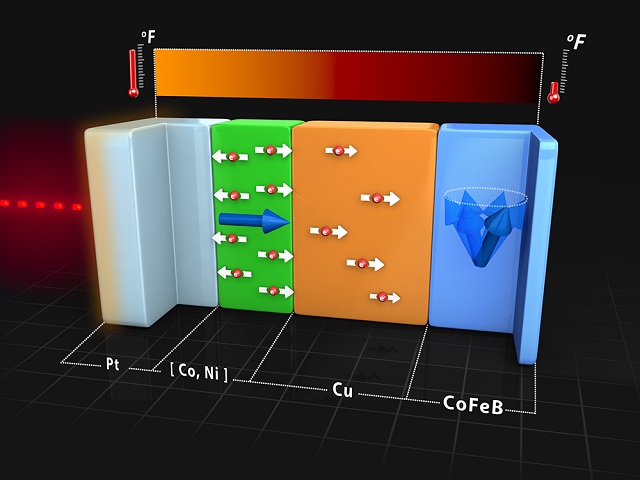 Schematic, cutaway view of the geometry used to generate currents of spin from currents of heat. Pulses of laser light heat the left side of the sample and create an intense current of heat passing through the [Co,Ni] ferromagnet. This current of heat creates a separation of electron spins that then diffuse through the Cu heat sink and affect the magnetization of a second ferromagnetic layer, CoFeB, causing the magnetization to tilt and then precess. The total thickness of the sample is approximately 100 nm. (Credit: Alex Jerez, Imaging Technology Group, Beckman Institute)
Schematic, cutaway view of the geometry used to generate currents of spin from currents of heat. Pulses of laser light heat the left side of the sample and create an intense current of heat passing through the [Co,Ni] ferromagnet. This current of heat creates a separation of electron spins that then diffuse through the Cu heat sink and affect the magnetization of a second ferromagnetic layer, CoFeB, causing the magnetization to tilt and then precess. The total thickness of the sample is approximately 100 nm. (Credit: Alex Jerez, Imaging Technology Group, Beckman Institute)
Researchers at the University of Illinois at Urbana-Champaign have reported physical mechanisms that use heat to manipulate magnetic information. Unlike the conventional methods that involve the application of magnetic fields, these mechanisms are based on the transport of heat energy, providing a suitable way to control magnetization at nano-level.
In our study, we make use of the fact that a heat current passing through a magnetic material creates a separation of electron spins. This process creates a current of magnetic dipoles that we use to manipulate the orientation of a second magnetic layer. The physics of separating spins with heat currents is related to the operation of thermocouples and the thermoelectric generators that power deep space probes. In those thermoelectric devices, a heat current causes a separation of electrical charges. That separation of electrical charge can then be used to measure a temperature or provide electrical power.
David Cahill, a Donald B. Willett Professor of Engineering and head of the Department of Materials Science and Engineering at Illinois.
“We use the spin current created by ultrafast heat conduction to generate spin transfer torque. Spin transfer torque is the transfer of the spin angular momentum from conduction electrons to the magnetization of a ferromagnet and enables the manipulation of nanomagnets with spin currents rather than magnetic fields. Spin transfer torque has often been realized by passing electrical currents through magnetic layers. In our paper, we showed how spin transfer torque can be generated by an intense current of heat,” explained Gyung-Min Choi, who recently completed his PhD in materials science and engineering at Illinois.
The research titled “Thermal spin transfer torque driven by the spin-dependent Seebeck effect in metallic spin-valves” was published in Nature Physics journal, and it was led by Choi. (The term “Seebeck effect” is a spin-dependent thermoelectric phenomenon that causes voltage generation based on the temperature differences between two dissimilar materials in a circuit. It can also be referred as an analogous phenomenon that allows spinning of electrons in the ferromagnet.)
We quantify thermal spin transfer torque in metallic spin valve structures using an intense and ultrafast heat current created by picosecond—one trillionth of a second—pulses of laser light. This heat current has the impressively large magnitude of 100 GW per square meter and persists for approximately 50 trillionths of a second. The sign and magnitude of the heat-driven spin current can be controlled by the composition of a ferromagnetic layer and thickness of a heat sink layer.
Cahill
The research group studied the physical mechanisms that regulate the interaction of heat and spin at nanoscale, besides addressing the basic limits of ultrafast spintronic devices in information processing and data storage. The work was also supported by the Army Research Office MURI program in addition to Cahill and Choi. The co-authors of the paper include Kyung-Jin Lee, Department of Materials Science and Engineering and KU-KIST Graduate School of Converging Science and Technology, Korea University, Seoul; and Byoung-Chul Min, Center for Spintronics Research, Korea Institute of Science and Technology, Seoul.
References